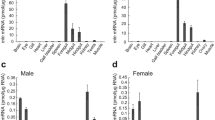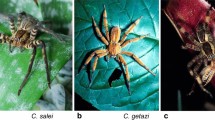Summary
-
1.
Intersegmental interneurons (INs) that participate in the larval bending reflex and the pupal gin trap closure reflex were identified in the isolated ventral nerve cord of Manduca sexta. INs 305, 504, and 703 show qualitatively different responses in the pupa than in the larva to electrical stimulation of sensory neurons that are retained during the larval-pupal transition to serve both reflexes. Action potentials produced by current injected into the 3 interneurons excite motor neurons that are directly involved in the larval and pupal reflexes. The excitation of the motor neurons is not associated with EPSPs at a fixed latency following action potentials in the interneurons, and thus there do not seem to be direct synaptic connections between the interneurons and the motor neurons.
-
2.
IN 305 (Fig. 2) has a lateral soma, processes in most of the dorsal neuropil ipsilateral to the soma, and a crossing neurite that gives rise to a single contralateral descending axon. IN 305 is excited by stimulation of the sensory nerve ipsilateral to its soma in the larva and the pupa. Stimulation of the sensory nerve contralateral to its soma produces an inhibitory response in the larva, but a mixed excitatory/inhibitory response to the identical stimulus in the pupa.
-
3.
IN 504 (Fig. 3) has a lateral soma, processes throughout most of the neuropil ipsilateral to the soma, and a crossing neurite that bifurcates to give rise to a process extending to the caudal limit of the neuropil and an ascending axon. IN 504 is excited by stimulation of the sensory nerve ipsilateral to its soma in both larvae and pupae, while the response to stimulation of the sensory nerve contralateral to its soma is inhibitory in the larva but mixed (excitatory/inhibitory) in the pupa.
-
4.
IN 703 has a large antero-lateral soma, a neurite that extends across to the contralateral side giving rise to processes located primarily dorsally in both ipsilateral and contralateral neuropils, and two axons that ascend and descend in the connectives contralateral to the soma (Fig. 4). IN 703 responds to stimulation of the sensory nerves on either side of the ganglion, but the form of the response changes during the larval-pupal transition. In the larva, the response consists of very phasic (0–2 spikes) excitation, but in the pupa there is a prolonged excitation that greatly outlasts the stimulus (Fig. 6).
-
5.
While the resting potential, and thus the relative spike threshold, of IN 703 appears to change during the larval-pupal transition (Fig. 9), hyperpolarizing IN 703 during a response shows that this difference can not account for the change in response properties (Fig. 10). Rather, IN 703 in the pupa is influenced by interneuronal inputs in the pupa whose effects are not expressed in the larva (Fig. 11).
Similar content being viewed by others
Abbreviations
- IN :
-
Intersegmental interneuron
References
Bacon JP, Altman JS (1977) A silver intensification method for cobalt filled neurons in whole mount preparations. Brain Res 138:359–363
Bate CM (1972) Neuronal control and differentiation of a pupal reflex in sphingid moths. PhD thesis, Cambridge University
Bate CM (1973a) The mechanism of the pupal gin trap. I. Segmental gradients and the connexions of the triggering sensilla. J Exp Biol 59:95–107
Bate CM (1973b) The mechanism of the pupal gin trap. II. The closure movement. J Exp Biol 59:109–119
Bell RA, Joachim FA (1976) Techniques for rearing laboratory colonies of tobacco hornworms and pink bollworms. Ann Entomol Soc Am 69:365–373
Booker R, Truman JW (1987) Postembryonic neurogenesis in the CNS of the tobacco hornworm, Manduca sexta. I. Neuroblast arrays and the fate of their progeny during metamorphosis. J Comp Neurol 255:548–559
Jacobs GA, Weeks JC (1990) Postsynaptic changes at a sensory-tomotorneuron synapse contribute to the developmental loss of a reflex behavior during insect metamorphosis. J Neurosci 10:1341–1356
Kent KS, Levine RB (1988) Neural control of leg movements in a metamorphic insect: persistence of the larval leg motor neurons to innervate the adult legs of Manduca sexta. J Comp Neurol 276:30–43
Laurent G (1986) Thoracic intersegmental interneurones in the locust with mechanoreceptive inputs from a leg. J Comp Physiol A 159:171–186
Laurent G (1988) Local circuits underlying excitation and inhibition of intersegmental interneurones in the locust. J Comp Physiol A 162:145–157
Laurent G, Burrows M (1988) A population of ascending intersegmental interneurones in the locust with mechanosensory inputs from a hind leg. J Comp Neurol 275:1–12
Levine RB (1986) Reorganization of the insect nervous system during metamorphosis. Trends Neurosci 9:315–319
Levine RB (1989) Expansion of the central arborizations of persistent sensory neurons during insect metamorphosis: the role of the steroid hormone, 20-hydroxyecdysone. J Neurosci 9:1045–1054
Levine RB, Truman JW (1982) Metamorphosis of the insect nervous system: changes in morphology and synaptic interactions of identified neurones. Nature 299:250–252
Levine RB, Truman JW (1985) Dendritic reorganization of abdominal motoneurons during metamorphosis of the moth, Manduca sexta. J Neurosci 5:2424–2431
Levine RB, Weeks JC (1990) Hormonally mediated changes in simple reflex circuits during metamorphosis in Manduca. J Neurobiol 21:1022–1036
Levine RB, Pak C, Linn D (1985) The structure, functions, and metamorphic reorganization of somatotopically projecting sensory neurons in Manduca sexta larvae. J Comp Physiol A 157:1–13
Levine RB, Truman JW, Linn D, Bate CM (1986) Endocrine regulation of form and function of axonal arbors during insect metamorphosis. J Neurosci 6:293–299
Levine RB, Waldrop B, Tamarkin DA (1989) The use of hormonally-induced mosaics to study alterations in the synaptic connections made by persistent sensory neurons during insect metamorphosis. J Neurobiol 20:326–338
Matsumoto SG, Hildebrand JG (1981) Olfactory mechanisms in the moth Manduca sexta: response characteristics and morphology of central neurons in the antennal lobes. Proc Roy Soc Lond B 213:249–277
Pearson KG, Robertson RM (1987) Structure predicts synaptic function of two classes of interneurons in the thoracic ganglia of Locusta migratoria. Cell Tissue Res 250:105–114
Robertson RM (1986) Neuronal circuits controlling flight in the locust: central generation of the rhythm. Trends Neurosci 9:278–280
Robertson RM, Pearson KG (1983) Interneurons in the flight system of the locust: distribution, connections, and resetting properties. J Comp Neurol 215:33–50
Sandstrom DJ, Weeks JC (1991) Reidentification of larval interneurons in the pupal stage of the tobacco hornworm, Manduca sexta. J Comp Neurol 308:311–327
Truman JW, Reiss SE (1988) Hormonal regulation of the shape of identified motoneurons in the moth, Manduca sexta. J Neurosci 8:765–775
Waldrop B, Levine RB (1988) Interneurons involved in multisegmental reflexes in larvae and pupae of the moth Manduca sexta. Soc Neurosci Abstr 14:1003
Waldrop B, Levine RB (1989a) Changes in synaptic inputs and cellular properties of an identified interneuron during insect metamorphosis. Soc Neurosci Abstr 15:67
Waldrop B, Levine RB (1989b) Development of the gin trap reflex in Manduca sexta: a comparison of larval and pupal motor responses. J Comp Physiol A 165:743–753
Weeks JC (1987) Time course of hormonal independence for developmental events in neurons and other cell types during insect metamorphosis. Dev Biol 124:163–176
Weeks JC, Ernst-Utzschneider K (1989) Respecification of larval proleg motoneurons during metamorphosis of the tobacco hornworm, Manduca sexta: segmental dependence and hormonal regulation. J Neurobiol 20:569–592
Weeks JC, Jacobs GA (1987) A reflex behavior mediated by monosynaptic connections between hair afferents and motoneurons in the larval tobacco hornworm, Manduca sexta. J Comp Physiol A 160:315–329
Weeks JC, Levine RB (1990) Postembryonic neuronal plasticity and its hormonal control during insect metamorphosis. Ann Rev Neurosci 13:183–194
Weeks JC, Truman JW (1984) Neural organization of peptideactivated ecdysis behaviors during the metamorphosis of Manduca sexta. II. Retention of the proleg motor pattern despite loss of the prolegs at pupation. J Comp Physiol A 155:423–433
Weeks JC, Truman JW (1985) Independent steroid control of the fate of motoneurons and their muscles during insect metamorphosis. J Neurosci 5:2290–2300
Weeks JC, Roberts WM, Trimble DL (1992) Hormonal regulation and segmental specificity of motoneuron phenotype during metamorphosis of the tobacco hornworm, Manduca sexta. Dev Biol 149:185–196
Author information
Authors and Affiliations
Rights and permissions
About this article
Cite this article
Waldrop, B., Levine, R.B. Intersegmental interneurons serving larval and pupal mechanosensory reflexes in the moth Manduca sexta . J Comp Physiol A 171, 195–205 (1992). https://doi.org/10.1007/BF00188927
Accepted:
Issue Date:
DOI: https://doi.org/10.1007/BF00188927




